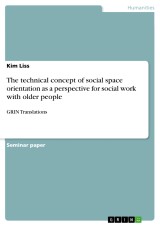Details

The technical concept of social space orientation as a perspective for social work with older people
GRIN Translations1. Auflage
|
13,99 € |
|
| Verlag: | Grin Verlag |
| Format: | |
| Veröffentl.: | 15.05.2024 |
| ISBN/EAN: | 9783389022801 |
| Sprache: | englisch |
| Anzahl Seiten: | 18 |
Dieses eBook erhalten Sie ohne Kopierschutz.
Beschreibungen
Seminar paper from the year 2018 in the subject Social Work, grade: 1,0, University of Duisburg-Essen (Soziale Arbeit), course: Konzepte sozialraumorientierter Arbeit, language: English, abstract: This text was translated with the help of AI and reviewed by the GRIN editorial team.
The aim of this paper is to emphasise the changes and significance of the ageing phase of life and to present the specialist concept of social space orientation as an enriching perspective for social work with older people. By way of introduction, the concept of social space orientation will be presented in general terms. Particular attention will be paid to the definition of social space and the explanation of the concept itself.
In order to provide as comprehensive an understanding of the concept as possible, the five basic principles of social space orientation are differentiated and declared separately. The following section then deals with the general phase of life of old age and its categorisation in the context of demographic change. In addition, various images of old age are presented in summarised form in order to illustrate the heterogeneity and diversity of old age. This is linked to the connection between social space orientation and the ageing phase of life. To this end, some of the advantages and perspectives of anchoring social space orientation in work with older people are emphasised in advance.
In order to both substantiate and further deepen this, the paper goes into more detail below on the social space of older people, which also emphasises the heterogeneity of old age described above. The paper then goes on to look more specifically at the conceptual realisation and design of the concept of social space orientation in relation to the requirements and needs of the older population.
This makes it possible to draw a conclusive, meaningful conclusion about the relevance and prospects of the concept of social space orientation for the ageing phase of life. To this end, this conclusion summarises the content and arguments previously identified and links them together. This is followed by a concluding assessment and a summary of the previously discussed significance of merging social space orientation with social work with older people.
The aim of this paper is to emphasise the changes and significance of the ageing phase of life and to present the specialist concept of social space orientation as an enriching perspective for social work with older people. By way of introduction, the concept of social space orientation will be presented in general terms. Particular attention will be paid to the definition of social space and the explanation of the concept itself.
In order to provide as comprehensive an understanding of the concept as possible, the five basic principles of social space orientation are differentiated and declared separately. The following section then deals with the general phase of life of old age and its categorisation in the context of demographic change. In addition, various images of old age are presented in summarised form in order to illustrate the heterogeneity and diversity of old age. This is linked to the connection between social space orientation and the ageing phase of life. To this end, some of the advantages and perspectives of anchoring social space orientation in work with older people are emphasised in advance.
In order to both substantiate and further deepen this, the paper goes into more detail below on the social space of older people, which also emphasises the heterogeneity of old age described above. The paper then goes on to look more specifically at the conceptual realisation and design of the concept of social space orientation in relation to the requirements and needs of the older population.
This makes it possible to draw a conclusive, meaningful conclusion about the relevance and prospects of the concept of social space orientation for the ageing phase of life. To this end, this conclusion summarises the content and arguments previously identified and links them together. This is followed by a concluding assessment and a summary of the previously discussed significance of merging social space orientation with social work with older people.
Diese Produkte könnten Sie auch interessieren:

Fallstudie Amy Jade Winehouse. Eine umfassende Analyse, Interventionen und Einblicke in die Einzelfallhilfe

von: Artemi Kapsalis

5,99 €

Geschichte der Sozialen Arbeit. Die Kita als soziales Dienstleistungsunternehmen

von: Artemi Kapsalis

13,99 €














